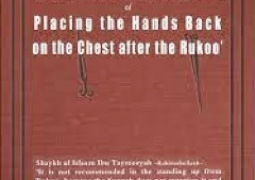The following are examples of when this may be done: becoming ill, fearing that one's wealth may be lost or destroyed, missing one's companions or traveling group, being overcome by sleep, and so on. This is based on the following hadith related by Jabir: "Mu'azh would pray 'isha with the Prophet sallallahu alehi wasallam, and then go and lead his people in salah. One night, the Prophet delayed salatul 'isha and Mu'azh prayed with him and then went to his people and led them in the night prayer by reciting al-Baqarah. One man left the salah and prayed by himself. The people said to him: 'O so and so, you have become a hypocrite.' He said: 'I have not become a hypocrite but I shall surely go to the Prophet and inform him of what has happened.' He told the Prophet what had happened and the Prophet said to Mu'azh: 'You put people to trials, Mu'azh! You put people to trials, Mu'azh. Recite such and such surah.'" This is related by the group.
Repeating a Salah with a Congregation
Yazid al-Aswad says: "We prayed dawn prayer (fajr) with the Messenger of Allah at Mina and two men came and stopped at their resting places. The prophet ordered for them to be brought and they came shaking with fear. The Prophet said to them: 'What prevented you from praying with the people? ...Are you two not Muslims?' They answered: 'Certainly we are, O Messenger of Allah, but we had prayed in our resting place.' The Prophet told them: 'If you pray in your resting places and then come upon an imam, pray with him, and it will be nafl for you.'" This is related by Ahmad and Abu Dawud. An-Nasa'i and at-Tirmizhi record it in these words: "lf you pray in your resting places and then you come to a mosque with a congregation, pray with them, and it will be nafl for you." At-Tirmizhi calls it hasan sahih and Ibn as-Sakin says it is sahih.
This hadith shows that it is correct for one to repeat a salah as a nafl with a congregation even if he has already performed it, individually or with a congregation.
It is related that Huzhaifah repeated the zuhr, 'asr, and maghrib prayers although he had prayed them in congregation. It is also related that Anas prayed fajr behind Abu Musa at the place where fruits are dried and then he went to the congregational mosque and repeated the salah behind al-Mughirah ibn Shu'bah. Nevertheless, this action contradicts authentic hadith of the Prophet sallallahu alehi wasallam in which he reportedly said: "Do not pray the same salah twice in one day." The apparent conflict has been resolved by Ibn 'Abdul-Barr who writes, "Ahmad and Ishaq agree that this refers to praying an obligatory salah and then, after a while, repeating it as the obligatory prayer. Now, as for the one who repeats the salah with a congregation with the intention that the second prayer is not a repeat of the obligatory salah but that it is simply a voluntary prayer, he obeys the Prophet's order of not making the same salah twice, as the first salah was obligatory and the second was nafl; hence, there is no repetition."
Imam's leaving the place after the salah
It is preferred for the imam to tum to the right or to the left after the salah and then to leave the place of prayer.
Qabaidah ibn Halb relates that his father said: "The Prophet would lead us in salah and then tum to both of his sides, to his right and to his left." This is related by Abu Dawud, Ibn Majah, and at-Tirmizhi. The latter calls it hasan. People who are informed on this subject act accordingly by turning to any side they wish. Both acts have been authenticated from the Prophet sallallahu alehi wasallam. 'Aishah says: "After the Prophet made the taslim, he would not sit except for the amount of time it takes to say: 'O Allah, You are the Peace, and from You comes the Peace. Blessed are You, Possessor of Majesty and Honor."' This is related by Ahmad, Muslim, at-Tirmizhi, and Ibn Majah.
Ahmad and al-Bukhari record that Umm Salamah said: "Whenever the Messenger of Allah finished his prayers with the taslim, the women would get up and he would stay in his place for a while before getting up." She said: "I think, and Allah knows best, that he did that to allow the women to leave before the men [would stand to leave].
The imam or followers being elevated
It is disliked for the imam to be at a higher place than the followers.
Abu Mas'ud al-Ansari says: "The Prophet sallallahu alehi wasallam prohibited that the imam should stand on something higher than the people behind him." This is related by ad-Daraqutni, while al-Hafez is silent about it in al-Talkhis.
Hamam ibn al-Harith relates that Huzhaifah led the people in prayer in Mada'in (Iraq) and he stood on a bench. Abu Mas'ud pulled his shirt with a strong grip. When he finished his prayer Abu Mas'ud said: "Do you not know that this has been prohibited?" Huzhaifah said: "Certainly, I know it. I remembered it when you pulled me." This is related by Abu Dawud, ash-Shaf'i, and al-Baihaqi. Al-Hakim, Ibn Khuzaimah, and Ibn Hibban grade it sahih.
On the other hand, if the imam has some reason for being higher than the followers, the act is not disliked. Sahl ibn Sa'd as-Sa'ady says: "I saw the Prophet sitting upon the pulpit on the first day that it was set up. He made the opening takbir while he was upon it and then he performed ruku'. Afterward, he moved behind the pulpit and made sajdah at the foot of the pulpit. Then, he repeated the same. When he had finished, he turned to the people and said: "O people, I did that for you to follow me and to teach you my salah."' This is related by Ahmad, al-Bukhari, and Muslim.: It is permissible for the followers to be at a higher place than the imam
Sa id ibn Mansur, ash-Shaf'i, al-Baihaqi, and al-Bukhari, in his comments, relate from Abu Hurairah that he prayed at the top of the mosque while following the imam. Anas used to pray in the room of Abu
Naf'i to the right of the mosque and the room was his height's high and its door faced the mosque of Basrah and Anas would pray in it, following the imam. The companions did not say anything about it. This is related by Sa'id ibn Mansur in his Sunan.
Ash-Shaukani observes: "If the follower is extremely high above the imam, for example, three hundred lengths, and he could not know what action the imam is doing then it is prohibited by consensus whether he is in a mosque or somewhere else. If it is less than that, it is permitted on the principle that unless proved otherwise a thing is permissible. This basis is supported by the above mentioned act of Abu Hurairah to which no one objected."
Following the imam with a barrier in between
It is allowed for a follower to follow the imam, even if there is a barrier between them, as long as he or she can tell the imam's movements either by his sight or hearing.
Al-Bukhari records: "Al-Hassan said: 'There is no problem if you pray and between you and him [the imam] there is a river.' Abu Majliz said: 'Follow the imam, even if between you and him there is a road or a wall, as long as you can hear the opening takbir.'" We have already mentioned the hadith in which the people prayed behind the Prophet sallallahu alehi wasallam while they were behind the room. <<<<<<<<<<<TO BE CONTINUED
Read Other Articles In Muslims Hands




